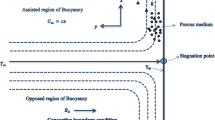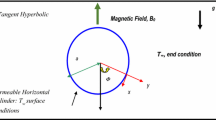Abstract
The two-dimensional quasi-steady conduction equation governing conduction controlled rewetting of an infinite cylinder with heat generation has been solved by Wiener–Hopf technique. The analytical solution yields the quench front temperature as a function of various model parameters such as Peclet number, Biot number and dimensionless heat generation rate. Also, the dry out heat generation rate is obtained by setting the Peclet number equal to zero, which gives the maximum permissible heat generation so as to prevent the dry out of the coolant.





Similar content being viewed by others
Abbreviations
- B :
-
Biot number
- C :
-
specific heat
- h :
-
heat transfer coefficient
- k :
-
thermal conductivity
- L :
-
length of the cylinder
- Pe :
-
Peclet number
- q″′ :
-
heat generation rate per volume
- Q :
-
dimensionless heat generation rate
- s :
-
half of the Peclet number
- t :
-
time
- T :
-
temperature
- u :
-
quench front velocity
- R, Z :
-
physical coordinates
- \( \bar{r},\bar{z} \) :
-
coordinates in quasi-steady state
- r, z :
-
dimensionless coordinates in quasi-steady state
- α:
-
transformed coordinate of z in complex Fourier plane
- θ:
-
dimensionless temperature
- φ:
-
modified dimensionless temperature of θ
- ρ:
-
density
- ξ, Ω:
-
variables used for integration
- Φ:
-
Fourier transform of temperature φ
- 0:
-
quench front
- 1:
-
wet region
- 2:
-
dry region
- cri:
-
dry out (critical) condition
- s:
-
saturation
- w:
-
initial wall condition
References
Tien CL, Yao LS (1975) Analysis of conduction controlled rewetting of a vertical surface. ASME J Heat Transfer 97:161–165
Levine H (1982) On a mixed boundary value problem of diffusion type. Appl Sci Res 39:261–276
Olek S (1988) On the two-region rewetting model with a step change in the heat transfer coefficient. Nucl Eng Des 108:315–322
Olek S (1994) Quenching of a composite slab. Int Comm Heat Mass Transfer 21:333–344
Evans DV (1984) A note on the cooling of a cylinder entering a fluid. IMA J Appl Math 33:49–54
Evans DV, Riley DS (1986) The solution of some diffusion problems by Fourier transform methods. Int J Heat Mass Transfer 29:1339–1347
Chakrabarti A (1986) The sputtering temperature of a cooling cylindrical rod with an insulated core. Appl Sci Res 43:107–113
Olek S (1989) Solution to a fuel-and-cladding rewetting model. Int Comm Heat Mass Transfer 16:143–158
Yao LS (1976) Rewetting of a vertical surface with internal heat generation. AIChE Symp Ser Solar Nucl Heat Transfer 73:46–50
Satapathy AK, Sahoo RK (2002) Rewetting of an infinite slab with uniform heating under quasi-steady conditions. ASME J Heat Transfer 124:875–880
Satapathy AK, Sahoo RK (2002) Rewetting of an infinite tube with a uniform heating. Heat Mass Transfer 38:589–595
Chan SH, Zhang W (1994) Rewetting theory and the dry out heat flux of smooth and grooved plates with a uniform heating. ASME J Heat Transfer 116:173–179
Dorfman A (2004) Transient heat transfer between a semi-infinite hot plate and a flowing cooling liquid film. ASME J Heat Transfer 126:149–154
Roos BW (1969) Analytical functions and distributions in physics and engineering. Wiley, New York
Barnea Y, Elias E, Shai I (1994) Flow and heat transfer regimes during quenching of hot surfaces. Int J Heat Mass Transfer 37:1441–1453
Acknowledgments
The present investigation has been carried out under the support from Grant No. F.26-14/2003, TSV, Dt. 14.01.04, MHRD, Government of India.
Author information
Authors and Affiliations
Corresponding author
Rights and permissions
About this article
Cite this article
Satapathy, A.K. Wiener–Hopf solution of rewetting of an infinite cylinder with internal heat generation. Heat Mass Transfer 45, 651–658 (2009). https://doi.org/10.1007/s00231-008-0457-6
Received:
Accepted:
Published:
Issue Date:
DOI: https://doi.org/10.1007/s00231-008-0457-6




